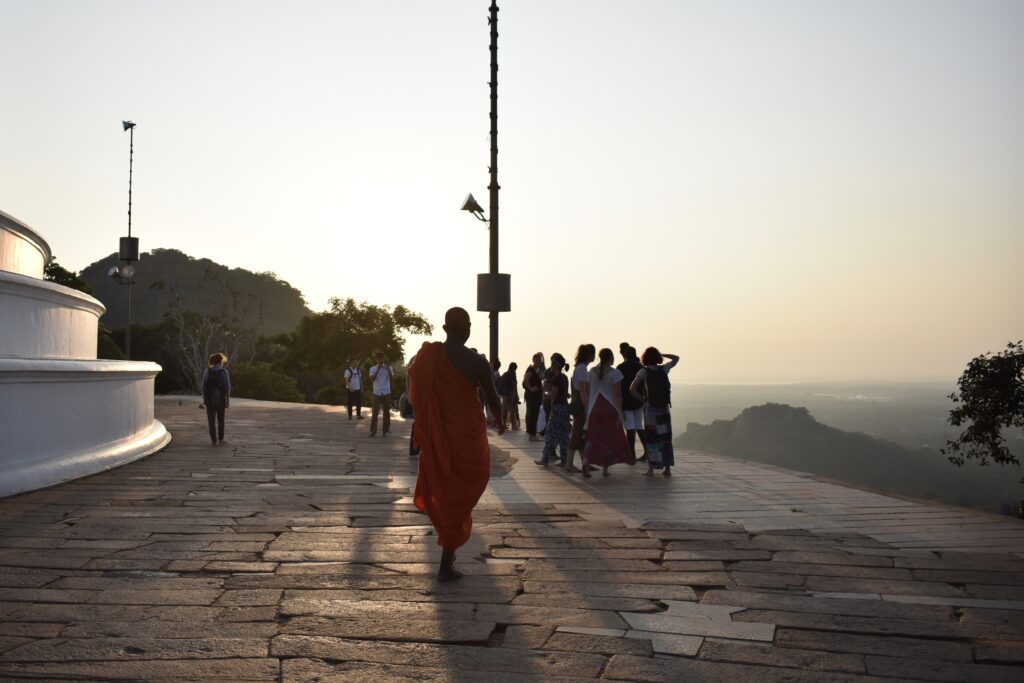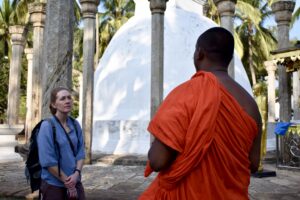By Abra Clawson ‘19
“So, the other tour guide was wrong, then?” one of our students asked from the back of the group. The branches of an enormous Bodhi tree stretched above us, the fence around it decorated with strings of Buddhist flags. Located in Anuradhapura, the tree is said to be one of the oldest in the world. It was the first Bodhi tree in Sri Lanka, planted using a branch from the tree in present-day India under which the Buddha reached enlightenment. The colors of the flags woven through the fences and branches were the subject of our discussion.
Our guide had just finished explaining the significance of the flag. Each color represented a different quality of the Buddha, he told the class. In his description, yellow was for the Buddha’s robes, orange for skin, and white for purity. The day before, a different tour guide in Polonnaruwa told us that the colors signified body parts of the Buddha. There, it was blue for eyes, orange for gums, white for teeth and bones, and red for blood. These colors come together in a final stripe to represent the Buddha’s multicolored aura.
Both men had authority as Sri Lankans and as official tour guides, yet the answers they provided conveyed the complications of searching for a single, “true” Sri Lankan reality.
Questions about the colors of monks’ robes elicited similarly mixed responses. One man in a small village near Kandy told us the differences in color is due to a monk’s status, with the head monk in the village wearing maroon while lower-status monks were orange. Days later beneath the Bodhi tree in Anuradhapura, the class was told that monks are just given whatever robes are available, and that the colors do not mean anything beyond what resources are offered. His answer also implied that some colors were more expensive to produce than others.
Taken aback by the contrast in the multitudes of answers from guides and locals we had talked to, some students immediately sought to find and label one answer as the “correct” one. They were asking questions which should have simple, concrete answers. Or so it seemed. This assumption is ultimately what led to the comment that one of the other guides had given us incorrect information the day before.
Later in the evening, after leaving the Bodhi tree behind, we clambered back onto our bus in order to drive to Mihintale. About a half hour’s drive from Anuradhapura, Mihintale is known as the site where Buddhism first came to Sri Lanka.
We were met in the parking lot by a monk who would be our tour guide, and would later be referred to as “everyone’s favorite.” He told us he was a “liberal, open minded” monk, and that he would answer any and all questions candidly.
The students immediately took to his openness, asking questions about the history of Mihintale, his own path as a monk, and the workings of the monastery. As our conversation continued over tea, he challenged some of the assumptions that students brought with them, especially about how and why people become monks. In our guide’s case, he had asked his mother to allow him to join the monastic community when he was 12 years old, going against his family’s wishes.
From the beginning, one of the goals of the UVM travel study course “Travel Writing in Sri Lanka” was to convey the various realities of this South Asian country and its people. In a country that has been involved in a 30-year civil conflict which ended barely a decade ago, it is especially important to acknowledge the differing experiences and stories of people living there. In addition, this context asks us to question why we hear certain kinds of answers, and maybe don’t hear others. Which histories are promoted, and which are pushed to the side as less valid – less “Sri Lankan”?
Over the course of our two weeks in Sri Lanka, this theme of stories and capital “T” Truth kept coming up. This culminated at the International Buddhist Museum in Kandy. As the Teaching Assistant for the travel writing class, I welcomed the opportunity to explore the museum by myself for an hour or so, while our class was observing and writing about the Temple of the Tooth complex across the street. As a religion major, I was intrigued by what information would be offered in the museum, and how it would connect to classes I have taken back in Vermont.
The first four rooms of the museum are all designed to explain the history of Buddhism in Sri Lanka, and the significance of various sites around the country. After traveling through this detailed description of Sri Lankan Buddhism, the visitor is expelled into the main hall, from which you can continue through the ground floor through rooms with artifacts from India, Nepal, Bhutan, Bangladesh, Afghanistan, and Pakistan. Or, you can walk up the central staircase to rooms on Thailand, Vietnam, Myanmar, Indonesia, Laos, Cambodia, Malaysia, China, Tibet, Japan, and Korea. This format of the museum in some ways mirrors the spread of Buddhism, and is accompanied by maps showing exactly how the different forms travelled across the continent. What was most interesting to me about this museum was the message conveyed about Buddhism which worked to give further authority to Buddhism in Sri Lanka specifically.
Take, for example, the single room containing objects from Nepal. Of the 15 or so pictures and items on display, the majority were from Lumbini, the birthplace of the Buddha. The introductory panel to the room stated that Theravada monks in Nepal are the most respected, although they consist of a much smaller population than the Tibetan or “Lamaist” monks. The only artefacts related to forms of Buddhism found in the Himalayas were a picture of Swayambhunath stupa and a model of Boudhanath stupa, both of which are in the Kathmandu valley. This dynamic stuck out to me because Theravada Buddhism is what exists in Sri Lanka, and is highlighted in the museum as being most important Nepal, even though it is the minority of Buddhists there. Thus, the museum seemed to be primarily an exercise of nationalism, even as it taught visitors about Buddhism throughout the world.
Museums are spaces which are widely assumed to be secular, objective, and authoritative – or close to it. The International Buddhist Museum calls each of these qualities into question. Walking its halls, I once again found myself questioning how and why certain Sri Lankan realities become more legitimate or popularized than others. Sri Lankan organizations often promote a unified national identity, yet little attention is given to the minority Tamil population that is predominantly Hindu. It has become a recurring discourse of “oh, and also…” which can be seen everywhere from the nation’s constitution (in reference to language and religion) to the conversations of people on the street. Yet in reality there is no single “Sri Lankan” way of life. This was made clear to our class again and again, with every contradicting explanation and every person we met.
Looking back, Mihintale was a turning point at which many students began to realize that they would never find the one capital-t True answer to their questions, and that a more interesting project is to look at the nature of the conflicting responses. Perhaps it was the openness of our favorite Monk-tour guide that allowed them to begin to shed their obsession with objectivity and their grip on Western frames of thinking. Perhaps it was the beauty of the dagobas and mountains at sundown. Either way, we left Mihintale with our energy refocused towards seeking out and accepting difference and small “t” contextual truths.


